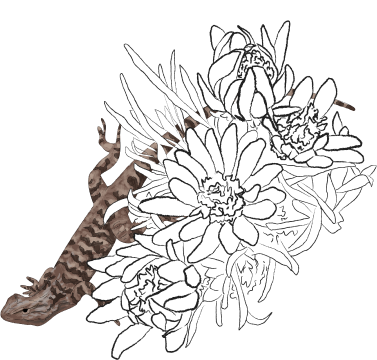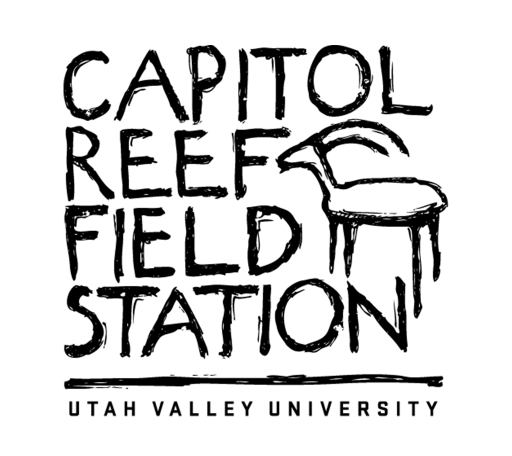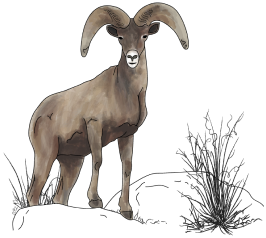Artemisia tridentata Nutt.
Viridiplantae > Streptophyta > Streptophytina > Embryophyta > Tracheophyta > Euphyllophyta > Spermatophyta > Magnoliopsida > Mesangiospermae > Eudicotyledons > Gunneridae > Pentapetalae > asterids > campanulids > Asterales > Asteroideae > Anthemideae >Artemisiinae > Artemisia [1]
![Artemisia tridentata at Glacier View Turnout on the Snake River [2].](/crfs/images/native-plants/plant-directory/bigsagebrush-first.jpg)
Artemisia tridentata at Glacier View Turnout on the Snake River [2].
Shrubs 4-20 dm tall with branches spreading to erect. Bark is flaky and gray with a shredded appearance. Vegetative branchlets 5-20 cm long, flowering branchlets surpass the vegetative in length. Leaves long-cuneate (narrowly triangular, wider at the apex and tapering toward the base) in shape, 0.5-5 cm long, tomentose (closely covered with down or matted hair), 3-5 toothed apically or the upper ones entire. Inflorescence paniculate (branched raceme in which each branch has more than one flower), 3-20 cm wide. Involucres (collection of bracts subtending a flower cluster) 3-5 mm long by 2-4 mm wide. Bracts 10-20 in number, canescent (grey or white in color due to a covering of short hairs) and green in color with scarious (thin, dry, membranous) margins. Flowers perfect (with male and female parts), 3-8, cream-yellow in color. Fruit achene (one-seeded fruit lacking special seams that split to release the seed) and glabrous (hairless) [3].
![Artemisia tridentata along the Virgin River [4].](/crfs/images/native-plants/plant-directory/bigsagebrush-sec.jpg)
Artemisia tridentata along the Virgin River [4].
The name ‘tridentata’ in Latin translates to “three-teethed” which refers to the lobes that are found on the apex of the leaves and is a defining characteristic when identifying this plant in the field. However, in Utah, there are five subspecies or varieties that are readily distinguishable as they tend to occupy distinctive habitats: var. parishii (Mojave sagebrush), var. tridentata (Basin sagebrush), var. vaseyana (Beetle, Mountain sagebrush), and var. wyomingensis (Wyoming sagebrush). It should be of note that herbarium specimens are very difficult to determine varietal status and plant habits need to be considered when determining varieties [3].
Meriwether Lewis collected the first type specimen for a woody species of Artemisia in North America on the banks of the Missouri River. Frederick Pursh then named it in Artemisia cana in 1814. In 1841, Thomas Nuttal gave the taxon the name Artemisia tridentata, the type of subgenus Tridentatae, along with naming most of the species of sagebrush that we recognize today. His descriptions were based on collections which he gathered during his third excursion throughout western North America [8].
![Close up of the flowering spikes (paniculate inflorescence) of Artemisia tridentata [5].](/crfs/images/native-plants/plant-directory/bigsagebrush-identification1.jpg)
Close up of the flowering spikes (paniculate inflorescence) of Artemisia tridentata [5].
![Closer look at the three-teethed leaves of Artemisia tridentata [6].](/crfs/images/native-plants/plant-directory/bigsagebrush-identification2.jpg)
Closer look at the three-teethed leaves of Artemisia tridentata [6].
![The three-teethed leaves and dried inflorescence on a Big Sagebrush plant [7].](/crfs/images/native-plants/plant-directory/bigsagebrush-identification3.jpg)
The three-teethed leaves and dried inflorescence on a Big Sagebrush plant [7].

![Big Sagebrush located in San Juan County, UT [11].](/crfs/images/native-plants/plant-directory/bigsagebrush-third.jpg)
Big Sagebrush located in San Juan County, UT [11].
Native Americans found many uses of the big sagebrush plant. In Utah, the Goshute tribe used it to treat fevers, colds, coughs, and as a remedy for most difficulties or disease. The infusion of the leaves were used for appendicitis and infections of the skin or bone. The leaves were also used as a covering over berries and other foods for preservation [12]. Big sagebrush is an important source of medicine, soap/disinfectant, food (seeds), and material for weaving mats and clothing. It is commonly burned as a smudge to cleanse the air for ritual purification and to promote good health by many Native American tribes. It is also an important browse plant, especially in winter, for many species including pronghorn, sage grouse, and rabbits [13].
![County-level distribution map of Artemisia tridentata [14].](/crfs/images/native-plants/plant-directory/bigsagebrush-fourth.jpg)
County-level distribution map of Artemisia tridentata [14].
This species is secure, as it is one of the most widespread shrubs in North America and is stable, maybe increasing, within its range.. Big sagebrush extends approximately from the Sierra Nevada in the west to the plains of the Rocky Mountains in the east. However, A. tridentata is not fire-tolerant and relies solely on wind-blown seeds from outside of the burn area for re-establishment. It does not resprout after fire or other disturbances [15].
Big sagebrush plants are well adapted and can thrive in several different types of habitats, including arid plains, valleys, foothills, and mountains of the West. Plants are drought tolerant and can grow in areas where precipitation can be as little as 200 to as much as 750 or more mm (8 to 30 in). It is often found growing in loamy to sandy loam soils, however, it has tolerance to alkaline or acidic soil. In general big sagebrush will grow in soils with a pH of 5.9 to 10.0 and with organic matter content of 0.62 to 4.14 percent [16]. Artemisia tridentata plants are extremely valuable natural resources. They provide ground cover and soil stability as well as habitat for various ungulates, birds, reptiles and invertebrates [17]. Sage grouse, for example, utilizes big sagebrush as nest cover, shelter, and food. Because A. tridentata is evergreen, it is a vital food source outside the growing season for Sage grouse, elk, mule deer, pronghorn, and pygmy rabbit, among others [18].
[1] Schoch CL, et al. NCBI Taxonomy: a comprehensive update on curation, resources and tools. Database (Oxford). 2020: baaa062. PubMed: 32761142 PMC: PMC7408187.
[2] Krzysztof Ziarnek, K. (2016a). Artemisia tridentata at Glacier View Turnout . photograph, Snake River, Wyoming https://commons.wikimedia.org/wiki/File:Artemisia_tridentata_kz23.jpg
[3] Welsh, S. L., Atwood, N. D., Goodrich, S., & Higgins, L. C. (2018). A Utah flora (5th, revised 2015 ed.). Marcus E. Jones Endowment Fund Monte L. Bean Life Science Museum Stanley L. Welsh Herbarium Brigham Young University.
[4] Kenraiz. (2016). Artemisia tridentata on Virgin River. photograph, Zion National Park, Utah https://commons.wikimedia.org/wiki/File:Artemisia_tridentata_kz17.jpg
[5] Dcrjsr. (2013). Big sagebrush (Artemisia tridentata) flowering spikes. At 7,000 ft (2,100 m) in Swall Meadows, Mono County. photograph, Eastern Sierra, California.
[6] Lane. (2024). Big Sagebrush (Artemisia tridentata). photograph, Terra, Utah. https://www.inaturalist.org/photos/388442612
[7] Harding , D. (2024). Big Sagebrush Artemisia tridentata. photograph, Escalante, UT . https://www.inaturalist.org/photos/385940749
[8] Shultz, L. M. (2009). Monograph of Artemisia Subgenus Tridentatae (Asteraceae-Anthemideae). Systematic Botany Monographs, 89, 1–131. http://www.jstor.org/stable/25592362
[9] Innes, Robin J. 2017. Artemisia tridentata subsp. vaseyana, mountain big sagebrush. In: Fire Effects Information System, [Online]. U.S. Department of Agriculture, Forest Service, Rocky Mountain Research Station, Missoula Fire Sciences Laboratory (Producer). Available: https://www.fs.usda.gov/database/feis/plants/shrub/arttriv/all.html
[10] Shultz, L. M. (2024, June 14). Artemisia tridentata. Artemisia tridentata - FNA. http://floranorthamerica.org/Artemisia_tridentata
[11] Peemus. (n.d.). Big Sagebrush Plant . photograph, San Juan, New Mexico https://commons.wikimedia.org/wiki/File:Sagebrushsjc.jpg
[12] Chamberlin, Ralph V., 1911, The Ethno-Botany of the Gosiute Indians of Utah, Memoirs of the American Anthropological Association 2(5):331-405.
[13] Springer et a. (2011). SW Field Guide . SEINet portal network - artemisia tridentata. https://swbiodiversity.org/seinet/taxa/index.php?tid=1369
[14] Artemisia tridentata Nutt. USDA plants database. (n.d.). https://plants.usda.gov/home/plantProfile?symbol=ARTR2
[15] Artemisia tridentata. NatureServe Explorer 2.0. (2010, November 17). https://explorer.natureserve.org/Taxon/ELEMENT_GLOBAL.2.1269543/Artemisia_tridentata
[16] Tilley, D. J., Ogle, D., St. John, L., & Benson, B. (n.d.). Big sagebrush - artemisia tridentata Nuttall. USDA plants. https://plants.usda.gov/DocumentLibrary/plantguide/pdf/pg_artrs2.pdf
[17] Monsen, S. B., & Shaw, N. L. (2000). BIG SAGEBRUSH (ARTEMISIA TRIDENTATA) COMMUNITIES - ECOLOGY, IMPORTANCE AND RESTORATION POTENTIAL. USDA. https://www.fs.usda.gov/rm/pubs_other/rmrs_2013_malone_s001.pdf
[18] Tirmenstein, D. 1999. Artemisia tridentata spp. tridentata. In: Fire Effects Information System. U.S. Department of Agriculture, Forest Service, Rocky Mountain Research Station, Fire Sciences Laboratory (Producer). Available online: http://www.fs.fed.us/database/feis/



